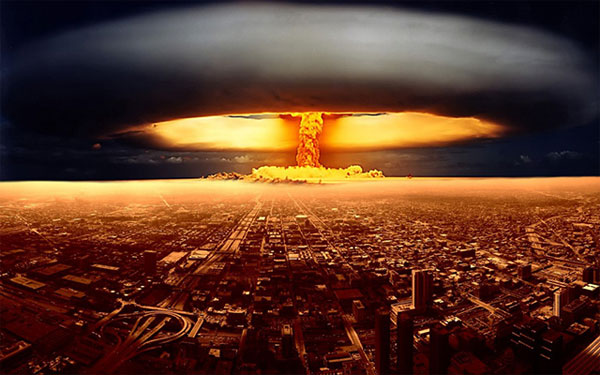What happens to the Earth after a nuclear war?
In a new study, the US team of meteorologists and environmentalists used a mathematical model to describe what happens after a limited and local nuclear war. Accordingly, immediately after the war, the global temperature will decrease from 2 to 3 degrees, the average annual rainfall will decrease by 9%, . The consequences will then lead to drought and crop failure. and famine in many parts of the world. Most notably, the Earth took 1,000 years to recover its normal temperature before the battle.
>>>The world's first underwater nuclear explosion
A hypothetical nuclear war
If in the past, we often only see nuclear war on movies or fiction, books, now scientists want to concretize its effects on Earth and children. people. To do that, the team assumed a nuclear war between the two countries X and Y.
At the height of the war, 100 nuclear warheads will be dropped into the Indian subcontinent, each about the size of the bomb dropped by the US army on Hiroshima in World War II. Next, the team will use mathematical models to predict what happens after 100 warheads are dropped.

Nuclear explosion
What happens after that?
Here is what the research team estimates:
- 5 million tons of black Carbon, the product produced when the explosion ignites everything, will immediately invade the atmosphere. Black carbon will absorb large amounts of thermal energy from the Sun, so the amount of heat reaching the Earth's surface will be significantly reduced. A black carbon amount can also follow rainwater falling back to the ground.
- 1 year later, the average temperature of the Earth's surface will decrease by about 2 degrees. After 5 years, the average temperature of the Earth will decrease by 3 degrees compared to before the war. 20 years later, the Earth's temperature will warm again about 1 degree, but it is still colder than before the explosion.
- The decrease in temperature results in a decrease in the amount of rainfall that the Earth receives. Five years after the war, average rainfall will decrease by 9% compared to normal. 26 years after the war, rainfall will be 4.5% less than before the war.
- From the second to the sixth year after the war, the growing season will lose 10 to 40 days depending on the region.
- The chemical reactions left by the war will erode the Earth's ozone layer. Five years after the war, the ozone layer will be 20 to 25% thinner. The next 10 years, the ozone layer can be recovered but still 8% thinner than before the war.
- Once the ozone layer is thinner, the Earth's protective layer is also weakened and the amount of ultraviolet rays from the Sun will cause people to burn more sunshine. The inevitable consequence is skin cancer. At the same time, the growth rate of plants is also declining and can cause even an imbalance of DNA in some plants.
- In another study conducted in 2013, the International Association of Doctors Against Nuclear War estimates that more than 2 billion people will starve after 100 nuclear bombs are used after the war. .
Those are some of the consequences that research groups envision about the scenario after a nuclear war. The team's goal is to call on countries to stop manufacturing and destroying nuclear weapons in the future. Currently an estimated 17,000 nuclear warheads are still stored around the world.
In the 1980s, scientists used "nuclear winter" to describe the prospect of nuclear war. Accordingly, the material after the explosion will cover the sky so that sunlight cannot shine on Earth and will have many months of winter. For this study, however, by applying computational models similar to global climate change estimates, the researchers draw a more detailed, detailed picture of the effects of war. Nuclear for Earth. However, nuclear war still has serious, long-term consequences that affect human survival.
- How will nuclear war destroy Earth?
- Earth temperature may change because of nuclear war
- The amount of nuclear warheads can destroy the Earth
- There was once a nuclear reactor flying above our heads
- The safest place on earth to avoid nuclear disaster
- How will nuclear weapons return Earth back to its original time?
- America uses nuclear weapons to protect the Earth from meteors
- Suspected that the crust shifted after the Korean nuclear test
- NASA will use nuclear technology to destroy meteors as it plunges into Earth
- What will happen if all the nuclear bombs in the world fire at the same time?
- Nuclear button of the US presidential life, it is now revealed
- Video: Three scenarios can cause the Earth to explode
 'Fine laughs' - Scary and painful torture in ancient times
'Fine laughs' - Scary and painful torture in ancient times The sequence of numbers 142857 of the Egyptian pyramids is known as the strangest number in the world - Why?
The sequence of numbers 142857 of the Egyptian pyramids is known as the strangest number in the world - Why? History of the iron
History of the iron What is alum?
What is alum?